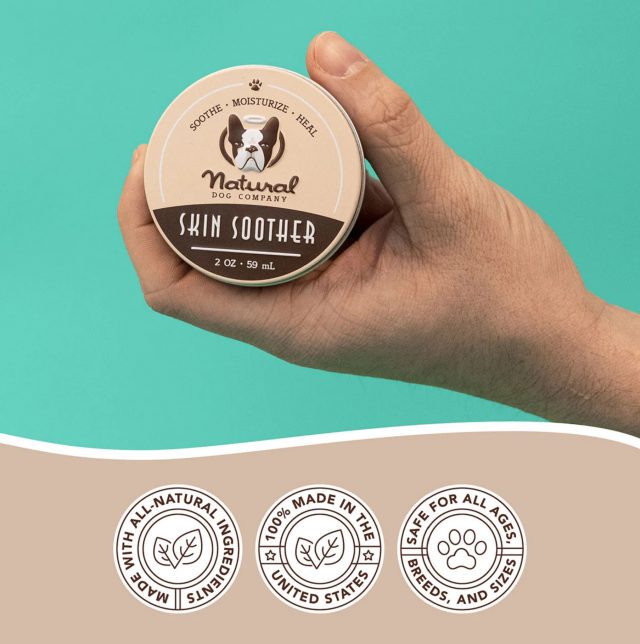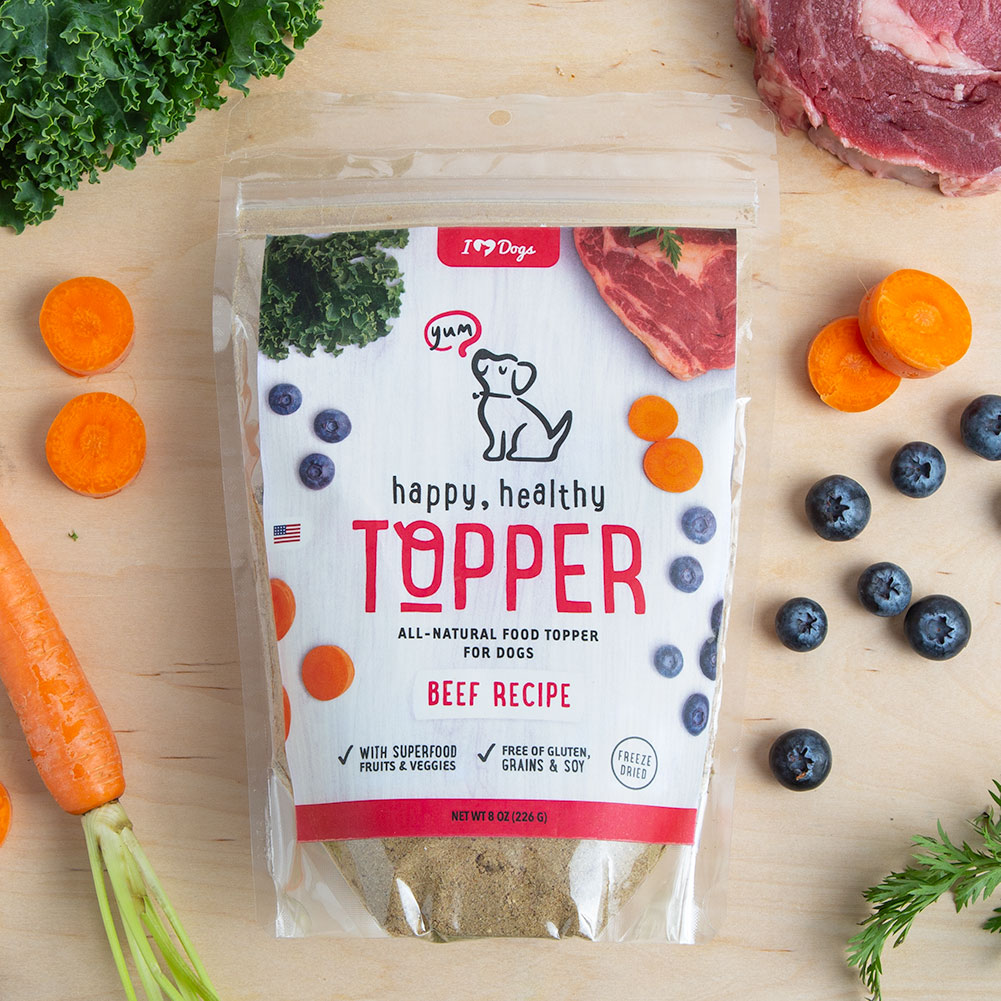
Did you know that almost a quarter of all vet visits are due to skin problems like itching and allergies? It’s the number one reason for a trip to the veterinarian. Dogs can suffer all sorts of skin-related problems, and itchiness and discomfort are just the beginning. Wounds that won’t heal, such as hot spots or lick granulomas; chronic yeast or bacterial infections; and even hair loss can result from itchiness and allergies.

Listening to your dog scratching all night long or watching their misery during the day can be frustrating to you as a pet parent. You want your dog to have the best life possible, and a life spent scratching, licking, or biting itchy skin was nowhere in your plans for a long, happy life for your dog. Luckily, there are a lot of natural remedies available on the market to help relieve your dog’s suffering. Here’s our guide to natural remedies for itchy dogs and dogs with allergic skin reactions.
Index
Determining The Problem
Dietary Concerns
Environmental Concerns
Common Allergies
Emotional Concerns
Natural Remedies For Rashes & Scratches
Conclusion
Other Resources
Determining The Problem
Time for a trip to the vet
It can be very difficult to pinpoint what’s causing your dog’s itchiness, and you will probably need to consult your veterinarian for a proper diagnosis. The vet will also help you formulate a thorough treatment plan for the actual cause of the itching rather than just healing your dog’s skin after they’ve been scratching it.
There is one cause of itching that you can check for yourself, however.
Parasites such as fleas, lice, and mites are one of the most common causes of itching in dogs. Luckily, with a thorough look at your dog, you can usually spot them, and getting rid of the parasites should stop your dog’s itchiness.
Fleas like to congregate around a dog’s ears and the base of the tail, although they can be found anywhere on a dog. They will typically be directly on the skin of the dog, so you’ll need to look underneath the hair to look for them. A better way to detect the presence of fleas is often to look for “flea dirt.” If you see black specks that look like pepper flakes, put a few onto a damp paper towel. “Flea dirt” is actually the excrement from fleas. Since they drink your dog’s blood, that’s also what they poop. Flea dirt will appear to bleed when it gets wet.
Lice are a very small brown or black parasite that tends to cling to your dog’s hair instead of the skin. They may resemble dirt, but they won’t rinse off easily the way you would expect dirt to do.
There are many shampoos, sprays, and other topical products that will kill fleas and lice. Please note that not all flea products will also work on lice – you need to read the packaging. Once the initial fleas or lice are killed, you will need to put your dog on a monthly preventative to avoid reinfestation. Once the fleas or lice have been eliminated, your dog’s itching should go away.
Mites are another insect that can plague dogs, but you are more likely to see the results of an abundance of mites rather than the microscopic pests themselves. There are two different types of mange, a skin problem caused by excessive mite populations on a dog’s skin that can lead to scabs and hair loss. Your vet may need to do a skin scraping to determine whether your dog is dealing with an infestation of mites and what kind of mites before coming up with an appropriate treatment plan.

Assess the severity of the problem
Your vet will want to know just how often and how badly your dog is scratching himself. Is it only a few times a day? Or is he scratching, chewing, and biting himself to the point where he is bleeding or has sores or hair loss? The more clues you can give your veterinarian, the easier it will be for them to determine what might be causing your dog’s itchiness.
It’s important to realize that scratching and itching are not problems – they are symptoms of problems. If you don’t find out which problem is causing the symptoms, your poor dog will likely never know anything more than just temporary relief from his itching.
Dietary Concerns
Food allergies are becoming a bigger and bigger problem in our pets. In fact, 10% of all allergy cases in dogs are food allergies. But what is a food allergy? According to Modern Dog Magazine:
“Food allergies are the over-response of your dog’s immune system to an invading protein. In the case of a food allergy, this protein is contained in your dog’s food. Proteins are present in most of the foods your dog eats. While most people recognize that meats are a source of proteins, there are also proteins present in grains and vegetables. Any one of these proteins has the potential to cause a food allergy.”
Some of the most common food allergens for dogs include:
- Beef
- Dairy
- Wheat
- Egg
- Chicken
- Lamb
- Soy
- Pork
- Rabbit
- Fish
- Corn
Most dogs that suffer from food allergies are allergic to more than one thing, which can make diagnosing food allergies extremely difficult.

Symptoms of food allergies include:
- Repeated ear infections
- Gastrointestinal problems
- Chronic diarrhea or gas
- Constant foot licking
- An itchy butt
- Dry, itchy skin
- Excessive scratching or licking
- Bald spots
- Hot spots
If your vet suspects that your dog has a food allergy, they will likely recommend that you try a hypoallergenic or food elimination diet. Either of these methods will help you to determine what ingredients your dog is allergic to. It is crucial that you listen to your vet’s directions to the letter, and don’t forget about treats! You may need to give hypoallergenic or single-ingredient treats like our All-Natural Free-Range & Grass-Fed Bully Sticks until you have pinpointed exactly what ingredients your dog is allergic to.
Deficiencies
While commercial dog food diets claim to include all the nutrients your dog needs to be healthy, the truth is that many are sadly lacking. Your dog may be deficient in any number of vitamins or other nutrients.
One nutrient that dog food is notoriously short on is omega-3 fatty acid. Omega-3 and Omega-6 are both essential fatty acids that work together to control inflammation. The trick is that they work best in a ratio of 3 to 5 parts of omega-6 for each 1 part of omega-3. The problem is that most commercial dog foods contain entirely too much omega-6 and not anywhere near enough omega-3. This can cause a wide variety of health problems, including allergies, arthritis, inflammatory bowel disease, heart disease, diabetes, liver or kidney disease, and cancer.
Adding an omega-3 supplement can help balance out the omega-6 your dog receives in his food and help improve your dog’s immune system and reduce the allergy symptoms that are causing his itching and misery.
There are also a wide variety of vitamins that your dog could be lacking, including Beta-Carotene (Vitamin A), Riboflavin (Vitamin B2), Niacin (Vitamin B3), Pyridoxine (Vitamin B6), Vitamin D, Vitamin E, and Vitamin K. Isolating which vitamin your dog may be lacking and trying to supplement with enough – but not too much – can be tricky. Many people choose to err on the safe side by giving their dog a nutritional boost powder like our Happy, Healthy ™ Food Toppers.
Solutions
Hypoallergenic commercial pet foods
Pros
- Convenient
- Easy
- Nutritionally complete
Cons
- Not natural
- Nutrients get lost during processing
- Contains artificial colors and preservatives
- Contains unnecessary fillers
Raw food diet
Pros
- Biologically appropriate
- Full of moisture
- Everything a dog’s body needs and nothing it doesn’t
- According to Dr. Karen Becker:
“Animals need unadulterated, fresh, whole foods that are moisture-dense. Animals don’t need grains, fillers, artificial preservatives, colors, additives, chemicals, byproducts, or processed foods.”
Cons
- It can be difficult to get started or make the switch.
- Can be messy
- May be difficult to make sure your dog is getting exactly the right amount of nutrients

Safety
Many people are concerned that raw meat can make their pet, themselves, or their family sick. The truth is that raw meat, when handled appropriately, is at least as safe as commercial dog food – which seems to announce a new recall every few weeks.
Most pathogens will be killed during the process of freezing meat. Varying types of meat should be frozen for anywhere from at least 24 hours for most types of meat to at least 3 weeks for any pork products. The freezing process should be enough to kill any pathogens and prevent your pet from getting sick.
Proper cleaning, hand-washing, and sanitization techniques will keep you and your family safe. Any methods that you use to keep your kitchen safe when working with meat for your own meal should be followed when making your dog’s meal. Wash your hands after touching any raw meat and disinfect any countertop, dish, utensil, your dog’s bowls, or anything else that comes in contact with raw meat, and you and your family should be just fine.
How to plan and prepare a raw diet
Planning and preparing a raw diet for your dog can be a scary thought when you first start thinking about switching your dog to a raw diet. WIll they even like the new food? Should you switch them gradually, or all at once?
One way to start making the transition from kibble to a raw diet is to start adding freeze-dried meat to your dog’s kibble. They will start to appreciate the taste and health benefits of real, raw meat while you plan the switch to a fully raw diet.
When you’re ready to finish transitioning your dog’s diet, here are some tips.
1. About 1/3 of your dog’s diet should consist of raw, meaty bones in order for them to get enough calcium and phosphorous. Some great examples include chicken wings, necks, legs, or thighs; turkey necks; beef tail bones; and lamb or goat necks or ribs. While cooked bones are very dangerous for dogs, raw bones are soft enough to cause fewer risks of choking or intestinal blockage.
2. Organ meat should make up 10-30% of your dog’s diet because it’s a great natural source of vitamins. No one source of organ meat should make up more than 10% of your dog’s diet by itself – liver, in particular, can cause diarrhea if it is included at too high a percentage of your dog’s diet. Organs include liver, kidney, spleen, brain, lung, testicles, pancreas, and thymus (pancreas and thymus are often sold as “sweetbreads”). Go easy on the organ meat when you first start your dog on a raw diet, and gradually increase the percentage. If your dog doesn’t like the taste of organ meat at first, you can fry it in a pan for a minute or two to make it more appetizing for a dog that is new to the raw diet. Keep in mind that heart is considered a muscle meat and not an organ.

3. Muscle meat should make up one half to one-third of your dog’s diet. The protein in muscle meat helps your dog build up his own muscles. According to Dogs Naturally Magazine, common meat choices include:
- Beef (ground beef, cheek meat, stewing beef)
- Beef heart (but not more than 5% of the diet as it’s very rich)
- Bison (ground bison, stewing bison meat)
- Turkey (ground turkey, boneless thighs, breast meat, tenderloin)
- Lamb (stewing lamb, ground lamb, shoulder or breast meat)
- Pork (pork shoulder or butt, cushion meat, boneless rib meat, loin)
- Chicken (boneless thighs, breast meat)
4. Limit fat to only 10-20% of your dog’s diet. While fat is crucial for nerve and immune function as well as skin health, using too much fat will cause a dangerous lack of vitamins and can lead to a wide variety of health problems. Meats that tend to be high in fat include poultry with the skin still on, ground beef that’s 85% lean or less, pork belly, and duck. Leaner meats include skinless poultry, lean ground beef, pork loin, rabbit, most fish, and most wild game apart from duck.
5. Fruits and vegetable are optional – but include a lot of great benefits not found in animal products. According to Dogs Naturally Magazine, here are some popular benefits to adding fruits and vegetable to your dog’s raw diet:
Prebiotics are indigestible plant fibers that feed important healthy bacteria that live in your dog’s gut (called probiotics). A little fiber probably helps your own digestion, right?
Chlorophyll is the green pigment in plants. It helps to make your dog’s cells healthy and detoxifies his liver and digestive system. It can also protect against cancer.
Carotenoids are important antioxidants that protect your dog from aging and disease. Carotenoids are found in yellow, orange, and red fruits and vegetables like squash, carrots, papaya, and cantaloupe.
Lycopene is another powerful antioxidant that can play a role in preventing and slowing cancer. Lycopene gives many vegetables their red color and it’s found in tomatoes, carrots, red cabbage, and watermelon.
Lutein is another antioxidant that’s known to protect the eyes, skin, and heart. It’s found in dark leafy greens and in yellow plants, including kale, broccoli, oranges, and papaya.
Flavonoids or bioflavonoids can regulate cell signaling and have antioxidant, anti-inflammatory, and anti-cancer properties. In general, the more colorful the plant, the higher it is in bioflavonoids.
Dogs are better able to extract nutrients from fruits and vegetables if they are lightly steamed or run through a juicer first.

6. Avoid starch. Starches like potatoes, peas, and grains are not only unnecessary for your dog’s diet, but they can actually cause hormone imbalances like insulin resistance and diabetes. Starch is a common filler in commercial dog foods because it’s cheap, but if it isn’t helping your dog with anything, there’s no good reason to add it to a raw diet.
7. Emphasize variety. Not only is eating the same thing every day boring, but it can lead to slight nutrient imbalances. Changing the variety of meats and organs that your dog gets on a regular basis not only keeps them interested in their food, but it is the best way to provide a well-rounded diet. Each and every meal doesn’t need to be balanced as long as the diet as a whole is balanced. Don’t forget to rotate in some “unusual” foods like poultry feet, beef trachea, tails, lung, testicles, and pizzles. Some of these items that we probably wouldn’t consider eating ourselves can be great sources of glucosamine and chondroitin, which help keep your dog’s joints healthy. It also tends to be cheaper than more popular cuts of meat, so don’t let the “ick” factor scare you away from these great additions to your dog’s raw diet!
8. Feed whole fish once a week. Whole fish are a great way to add natural fats and oils to your dog’s diet, but you don’t want them to be more than 5% of your dog’s overall diet. One meal a week of whole fish like sardines, smelts, herring, or mackerel can help your dog get the benefits of fatty acids without consuming too much overall fat.
9. Feed your dog about 2-3% of his ideal adult weight each day. That means a 50-pound dog should receive about a pound of food a day. Dogs that exercise a lot and growing puppies may need more food than that, and dogs who are couch potatoes or need to slim down a little bit may need less than that. You should assess your dog’s weight regularly when feeding a raw diet. You should be able to feel their ribs but not see them.
10. Disinfect everything. Just like preparing meat for yourself, you will want to disinfect everything after your dog’s food has been prepared and eaten. Some people prefer to feed their dogs outside or in a kennel to prevent bacteria from potentially getting on floors or other surfaces.
Environmental Concerns
There are a lot of environmental concerns that can cause itchiness in your dog. Dry skin is a common culprit. Does your dog seem itchier in the dryness of winter? Do you wash your dog more than a couple of times a month? Do you live in an extremely dry climate? All of these factors could cause dry, itchy skin on your dog. Try using humidifiers around the house – your own skin will benefit from the extra moisture in the air, too!
It is also possible that your dog is interacting with something else in the environment.
For example, if your dog started itching worse after a bath, there may have been some shampoo residue left in your dog’s coat, or they could be reacting to the shampoo itself. Always make sure you are using a shampoo formulated specifically for dogs – humans and dogs have different pH levels, and even baby shampoo for humans can dry out a dog’s skin. A hypoallergenic shampoo, rinsed out extremely well, should help reduce irritation related to baths.
Anything in your dog’s natural environment may cause itchiness. You may need to look back and see if anything around your home happened or changed around the time that your dog started itching. Did you have your carpets cleaned? Did a pest control company spray your yard? Have you started using a new laundry detergent? Narrowing down causes for your dog’s itchiness can help you eliminate environmental causes for your dog’s itchiness.
Common Allergies
Just like humans, dogs can be allergic to any number of things. If your dog seems to suffer all year round, your dog may be dealing with an allergen in your home such as dust or dust mites. If your dog gets itchier during certain times of the year, such as spring or fall, he may be dealing with a seasonal allergy to something like pollen.

Solutions
Luckily, there are several things you can do to help minimize your dog’s exposure to environmental issues and common allergens. Here are some tips for helping your dog manage.
- Bathe your dog regularly with a hypoallergenic shampoo and rinse well. If your dog’s skin is coming into contact with an allergen, washing them or wiping them down with a grooming wipe on a regular basis will help remove the allergens before they can cause your dog as many problems with itching.
- Keep your home clean. Dogs that are allergic to things like dust or dust mites will appreciate the effort you put into dusting and vacuuming your home consistently.
- Do laundry often. This goes along with keeping your house clean. Washing sheets and removable dog bed covers can make a big difference in your dog’s comfort level if he’s dealing with environmental allergies.
- Wipe his feet when he comes in the house. Dogs pick up a ton of pollens, dust, dirt, and other environmental allergens on their feet every time they go outside. Wiping your dog’s feet off with a wet rag or a grooming wipe every time he comes back inside can help remove those allergens before they start to bother him – and before they spread throughout your home.
Emotional Concerns
To complicate matters, dogs that lick, scratch, or chew themselves obsessively may be dealing with an emotional problem rather than a physical problem. Dogs have very limited ways to deal with things like stress and anxiety, so they tend to resort to compulsive behaviors such as licking, scratching, and chewing themselves. If your vet can’t find a physical cause for your dog’s itching, it may very well be an emotional problem. Those can be a little bit trickier to treat than a physical problem. Here are a few issues that may cause your dog to scratch or lick themselves all day long.
Types of issues
- Stress. Lots of things can cause a dog to suffer from stress. Examples include a major change in their daily routine, the loss of a furry friend, a new addition to the family, or constant stress from the human family members.
- Depression. Yes, dogs can be depressed. Usually, this is the result of lack of exercise, lack of stimulation, or lack of attention. If you’ve been out of the house more than usual, for example, your dog may be depressed about not getting to spend as much time with you.
- Boredom. Leaving your dog home alone all day with little to entertain them can lead to boredom. If there’s nothing to interest them in their environment, they may keep themselves busy by licking a spot on their leg bald.
- Anxiety. Any form of anxiety can lead a dog to develop compulsive behaviors, but the most common cause is probably separation anxiety. Licking can be a self-soothing mechanism, so if your dog gets upset every time you leave the house, they could be trying to make themselves feel better by compulsively licking the same spot over and over again.
- Pain. Dogs are experts at hiding their pain, so if they can manage not to limp, you may not realize they are experiencing joint pain. Again, licking is soothing, so if your dog’s licking seems located directly over a joint, head to the vet to see if there’s a problem.

Solutions
- Dogs that suffer from separation anxiety may get some relief from their anxiety if they are left with an item that smells like you to soothe them. The Comfort Cuddler is a great way to let your dog smell your presence while you’re gone – just place a piece of clothing you’ve recently warm inside and close it up. Your dog can cuddle with your scent without tearing up your article of clothing!
- Dogs that are bored, depressed, or stressed can benefit from having puzzle toys or toys filled with peanut butter and then frozen left out for them to give them something interesting to do while you are gone.
- Almost all dogs could benefit from a little bit more exercise. Try taking your dog for a longer walk in the morning and see if that helps your dog’s symptoms subside.
- Spend more time with your dog when you are home. We all get busy, but sometimes it’s our furry family members that suffer the most. Try spending even just an extra 15 minutes a day interacting and playing with your dog. That extra attention when you are home may make them feel comfortable enough to stop stressing – and licking – as much when you’re gone.
Natural Remedies For Rashes & Scratches
Topical Remedies
While the best long-term solution for your dog’s itching is treating the underlying problem, you still want your dog to get some relief in the meantime. Luckily, there are plenty of natural remedies for rashes, scratches, and patches of dry or irritated skin, some of which you may already have around the house. These products can be used topically to help soothe your dog’s irritated skin. Keep in mind that while many of these remedies can be safely licked by your dog, licking often makes skin problems worse, so you’ll want to try to keep your dog’s tongue away from affected areas anyway.
- Almond Oil is a medium-light oil that is easily absorbed by the skin and helps retain moisture. It’s hypoallergenic and it won’t make your dog sick if he licks it off. It contains protein, several vitamins, fatty acids, and omega-3. It’s ideal for dry skin, itching, burns, inflammation, and flakiness.
- Argan Oil is a popular ingredient in human hair and skin products these days thanks to its amazing hydrating properties, but it is a little controversial to use it on dogs. Used in very small amounts on areas of dry skin that your dog won’t lick (or that you prevent them from licking), argan oil can help reduce inflammation, dandruff, itchiness, and dry skin. It can help soothe dry paw pads, too. If your dog licks too much of it off, though, it can cause pancreatitis and kidney problems.
- Avocado Oil is absorbed easily and is very beneficial for moisturizing dry skin. While most parts of an avocado are toxic for dogs – including the leaves, bark, skin, and pit – avocado oil is safe enough for your dog to lick off after you apply it to his skin. Consuming large amounts of avocado oil could make your dog feel nauseous, but for spot treating a few problem areas, it should be just fine.

- Cocoa Seed Butter, also called theobroma oil, is the fat extracted from the cacao seed. It contains a blend of fatty acids and antioxidants that help protect the skin and reduce inflammation. While cocoa butter is one of the ingredients used to make chocolate, which is toxic to dogs, all the toxins are in cocoa powder, meaning the butter is safe for dogs to lick in small amounts – although it’s very high in calories, so it can cause weight gain in anything but small amounts.
- Coconut Oil has a ton of benefits for your dog whether you choose to use it topically or add a little bit to their diet. Fed to your dog, it can support skin and coat health, thyroid function, digestive system health, and immune system health. Used topically, it can improve hot spots, bites, stings, or itchy, dry skin. You can check out our Project Paws® Organic Virgin Coconut Oil here.
- Neem Oil used topically can help repel parasites like mosquitoes and fleas and may be effective in improving ringworm, demodectic mange, hot spots, inflamed skin, and itchiness. It can have a very strong odor that can be unappealing to some. After applying it to your dog’s skin, you should try not to let him lick it off, as ingesting it may cause stomach upset.
- Olive Oil has been used as a natural moisturizer for thousands of years. It penetrates deep into the skin while also providing a cleansing effect, and it won’t clog pores. Olive oil contains the antioxidants vitamin E, polyphenols, and phytosterols which all help improve your dog’s overall skin quality.
- Shea Butter is not only a great moisturizer for your dog’s skin, it has anti-inflammatory properties and absorbs into his skin without leaving him feeling greasy. It’s also unlikely to make your dog sick if he licks it off.
Why not choose an All-Natural Pet-Safe Balm that contains all of these ingredients and more? Why limit yourself to just one oil when you can get the benefits of multiple different oils for your dog with one product that you and your dog will love?
Balms are a convenient, effective way to help ease your dog’s skin problems, and they may be safe even if your dog licks them.
When deciding on which balm to try for your dog, you’ll want one that’s made in the United States from ethically-sourced ingredients.
Natural Dog Company Skin Soother® heals and soothes dry, itchy skin with 100% organinc, plant-based ingredients, like lavender, chamomile, and frankincense. Cocoa butter, sweet almond oil, coconut oil, and vitamin E come to together to make a rich salve that’s perfect for dogs with minor skin irritations and soothes a variety of issues including, but not limited to, scratches, scars, rashes, scabs, crusty ear edges, clipper/brush irritation, and more. The lightly scented formula is packed with soothing oils and butters that deliver anti-inflammatory, disenfecting, and antiseptic properties. It’s moisture and healing in one.

Natural Dog Company soothing balms, nourishing supplements, grooming products, and treats provide health & wellness solutions for dogs and peace of mind for their humans. Every formulation contains only safe, natural ingredients and never any pesticides, chemically-enhanced fertilizers, or other harmful additives. And no product leaves this cruelty-free company’s warehouse without approval from trusted veterinarians. Plus, Natural Dog Company has a treat when you shop with them.
Get 15% off your first order when you shop from Natural Dog Company!
Internal remedies
Antihistamines
Antihistamines can help 10-30% of dogs find relief from their allergy symptoms. While some antihistamines that are available over the counter for humans are safe for dogs, you should always contact your veterinarian before giving your dog any medications. Your dog may have an underlying health issue that could be complicated by the addition of any medications, so be sure to discuss this topic thoroughly with your vet.
Antihistamines can start to work within 30 minutes to help your dog find relief from his allergies. Given 2-3 times a day, antihistamines can help significantly reduce your dog’s allergy symptoms. They aren’t appropriate for every dog, though. Dogs with the following health conditions shouldn’t take antihistamines unless a veterinarian prescribes it and provides oversight:
- Glaucoma
- Respiratory problems
- Heart problems
- Urinary retention
- Liver or kidney problems
- Seizures
- Puppies
- Dogs who are pregnant or nursing

Antihistamines can also cause side effects. The most common side effect, drowsiness, typically wears off after a while if you give it to your dog regularly. Other side effects may include:
- Dry mouth
- Urinary retention
- Sluggish reactions
- Diarrhea
- Vomiting
- Loss of appetite
- Allergic reaction
- Excitement
Some side effects may be severe, and overdoses, while rare, can occur and can occasionally be fatal.

Benadryl is the most commonly-prescribed antihistamine for dogs. The active ingredient is diphenhydramine, and you’ll want to make sure that’s the only active ingredient listed. Some types of Benadryl include other active ingredients such as Tylenol that may be toxic to your dog.
Always talk to your vet first, but Benadryl tablets are generally dosed at 1 mg per pound of your dog’s weight. The tablets are usually 25 mg, so one tablet would be perfect for a 25-pound dog, 2 would be needed for a 50-pound dog, 3 for a 75-pound dog, and so on.
For very small dogs, liquid dosing may be easier than trying to give a fraction of a pill. If you choose to give your dog liquid Benadryl, always choose a children’s variety, as adult’s liquid Benadryl may contain alcohol or Xylitol, both of which are toxic to dogs. The standard formulation of liquid Children’s Benadryl is 12.5 mg of diphenhydramine (the active ingredient) per 5 mL of liquid. Dogs should receive 0.4 mL per pound, so a 10-pound dog would need 4 mL, a 5-pound dog would get 2 mL, and a 15-pound dog would need 6 mL.
A measuring teaspoon contains 5 mL, so you will want to use a syringe to accurately measure doses of liquid Benadryl. Most dogs don’t enjoy the same flavors as human children, so using a syringe (without a needle) can also help you get the liquid toward the back of your dog’s throat with less fuss.
Quercetin is a bioflavonoid found in fruits and vegetable that has been called “nature’s Benadryl” for its antihistamine properties. It’s generally considered safe in dogs at appropriate dosages. It shouldn’t be given to dogs with kidney problems, and it can harm the kidneys in high doses. It’s not intended for long-term use; it should be used on an as-needed basis.
To determine the proper dosage of quercetin for your dog, multiply your dog’s weight in pounds by 1000, then divide by 125 to get the daily mg dosage, which should be split into 2 doses per day. For example, for a 50-pound dog, you multiply 50 by 1000 to get 50,000, then divide 50,000 by 125 to get 400 mg. So a 50-pound dog should receive two 200 mg doses per day.

Steroids
For dogs with moderate to severe allergies and dogs whose symptoms weren’t treated successfully with antihistamines, corticosteroids are usually the best treatment for allergies. They can effectively control inflammation and bring dogs serious itching relief. Two popular choices these days are Atopica and Apoquel.
Both can work very quickly to help reduce even fairly severe symptoms of allergies, and they can bring immense relief to dogs that have been suffering.
The problem is that they both work by suppressing your dog’s immune system, which opens your dog up to the possibility of secondary infections. Apoquel has even been implicated in an increased risk of developing several different types of cancers. Other side effects of corticosteroids like Atopica and Apoquel include:
- Persistent swimmer’s ear
- Urinary tract infection
- Anorexia
- Lethargy
- Lymphadenopathy (swelling of lymph nodes)
- Pneumonia
- Demodectic mange
If steroids seem to be the best treatment option for your dog, talk to your veterinarian about giving your dog the lowest effective dose for the shortest period of time possible to try to control your dog’s symptoms with a lower risk of side effects.
Supplements – Longer term
Luckily, there are some supplements that may help your dog. Omega fatty acids have been shown to reduce allergies and inflammation. They may even help slow the growth of some cancers. It just so happens that we have a couple of fatty acid products that can not only help your dog, but each purchase helps to feed shelter dogs!
Omega 3-6-9 Select Grain Free Skin & Coat Chews with Pure Antarctic Krill Oil are grain-free, gluten-free, soy-free treats made with sustainably-sourced krill meal that dogs love. They were formulated by veterinarians to provide an unparalleled boost to your dog’s health in the most natural, sustainable way possible in a supplement. The chews contain essential omega-3, omega-6, and omega-9 fatty acids, including EPA, DHA, and GLA –it’s one of the only supplements offering GLA. Each purchase provides 14 meals for shelter dogs.
Looking for an omega-3 supplement that also helps improve your dog’s teeth? Check out our Pure Antarctic Krill Sticks! The world’s first omega-3 + dental stick boosts skin, coat, and dental health. Kill 2 birds with one stone – improve your dog’s skin while he cleans his teeth! They’re grain-free, gluten-free, and contain no artificial coloring. Each purchase provides 14 meals for shelter dogs.
There are several other different types of dog-safe natural anti-inflammatory supplements on the market today, including bromelain, boswellia, curcumin, vitamin E, and nettle leaf. Anti-inflammatories can help reduce itching caused by allergies.
Conclusion
While it can be extremely frustrating to see your dog suffer from allergies, itchiness, and other skin problems, there are a wide variety of options out there to try to help your dog with his symptoms. It may require a lot of trial and error, but odds are that there are one or more options to help bring your dog some relief from his symptoms.
Other Resources
- Raw Feeders Facebook group
- 10 Common Skin Issues In Dogs
- What Are Hot Spots In Dogs?
- 5 Things You Should Know About Lick Granulomas
- The 5 Major Parasites That Could Threaten Your Dog’s Health
- Think Your Dog Has Mange? Know Which Is Which To Ditch The Itch
- 8 Foolproof Steps To Prevent Ear Infections In Dogs
- Is Your Dog Constantly Biting Their Paws? Here’s How You Can Help
- The Easiest Way to Start Your Dog on a Raw Diet
- What To Do for Dogs with Itchy Dry Skin in Winter: 6 Soothing Strategies
- Dog Allergies: How To Spot, Treat Naturally, And Help Prevent
- 6 Tips & Tricks To Make Being Home Alone Less Stressful For Your Dog
- 5 Signs Your Dog Is Dealing With Depression
- 5 Signs Your Dog Is Bored And How To Overcome It
- 5 Signs Your Dog Has Separation Anxiety
- 5 Signs Your Dog Is In Pain
- 3 Clear Signs Your Dog Needs More Exercise
- Canine Cancer: What To Know And How To Help
- Allergies In Dogs: How Benadryl Or This Natural Alternative Could Help
- 5 Things Dog Owners Should Know About Giving Benadryl To Dogs

Sources
- PetMD
- Tufts
- Modern Dog Magazine
- WebMD Pets
- Dogs Naturally Magazine
- Mercola Healthy Pets
- One Green Planet
- Dogs Naturally Magazine
- Preventive Vet
- My Dog Foo
- Krill Oil For Dogs
- My Dog Foo
- AKC
- PetMD
- Dogster
- Natural Dog Company
- Natural Dog Health Remedies
- Veterinary Place
- Dogs Naturally Magazine
- VCA Hospitals
- PetMD
- Dogs Naturally Magazine
- Mercola Healthy Pets
- PetGuide
- PetMD
- Organic Facts
The post The Complete Natural Remedies Guide For Itchy Dogs And Dogs With Allergic Skin Reactions appeared first on iHeartDogs.com.
via Whisker Therapy



